 W
WArthur Louis Aaron VC, DFM was a Royal Air Force pilot and an English recipient of the Victoria Cross, the highest award for gallantry in the face of the enemy that can be awarded to British and Commonwealth forces. He had flown 90 operational flying hours and 19 sorties, and had also been awarded posthumously the Distinguished Flying Medal.
 W
WDominic Bruce, was a British Royal Air Force officer, known as the "Medium Sized Man." He has been described as "the most ingenious escaper" of the Second World War. He made seventeen attempts at escaping from POW camps, including several attempts to escape from Colditz Castle, a castle that housed prisoners of war "deemed incorrigible".
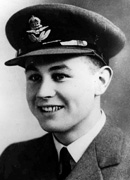 W
WCyril Joe Barton, VC was a Second World War bomber pilot in the Royal Air Force who received the Victoria Cross, the highest award for gallantry in the face of the enemy that can be awarded to British and Commonwealth Armed Forces.
 W
WBlaster Bates was the name used by Derek Macintosh Bates, an English explosives and demolition expert and raconteur, who was born in Crewe. He made a series of sound recordings from the 1960s to 1980s, recounting bizarre and funny experiences from his long career, and tales of his hobbies of motorcycling, hunting and shooting. He was much in demand as an after-dinner speaker. His tales feature coarse language and their content is equally strong stuff for the period. Once, for instance, he was hired to clear out a farm's septic tank using explosives, an episode Bates described as "The Shower of Shit Over Cheshire" On another occasion he surprised a young couple in what he described as 'a compromising position' whilst clearing trees for the Oulton Park racing circuit, an incident which gave the Knickerbrook corner its name.
 W
WIan Willoughby Bazalgette, was a Canadian-British pilot in the Royal Air Force during the Second World War. On 4 August 1944, while piloting an Avro Lancaster in a pathfinder role, Bazalgette and crew flew to Trossy St. Maximin in France to mark a V-1 flying bomb storage cave. Bazalgette's Lancaster was severely damaged by flak prior to arrival at the target and quickly set on fire. Despite the condition of his aircraft, Bazalgette continued to the target and accurately dropped his markers. After completing the task, Bazalgette ordered his crew to bail out, however, two members of the crew were wounded and unable to jump. Rather than saving himself and leaving the two men to die, Bazalgette attempted to land the burning plane to save his two crew members. Bazalgette landed the plane, but it exploded almost immediately upon alighting, killing all three airmen. For his actions, Bazalgette was posthumously awarded the Victoria Cross.
 W
WSquadron Leader Anthony Orlando ‘Oscar’ Bridgman, DFC was a bomber pilot of the Royal Air Force during the Second World War. He was awarded the Distinguished Flying Cross in 1940, and, during internment as a prisoner of war at Stalag Luft III, was a contributor in The Wooden Horse escape.
 W
WLeslie George Bull, known as Johnny, Les or Lester Bull, was a British Vickers Wellington bomber pilot who was taken prisoner during the Second World War. He took part in the 'Great Escape' from Stalag Luft III in March 1944, but was one of the men re-captured and subsequently shot by the Gestapo.
 W
WKenneth Campbell, was a Scottish airman who was posthumously awarded the Victoria Cross for an attack that damaged the German battlecruiser Gneisenau, moored in Brest, France, during the Second World War.
 W
WMichael James Casey, known as "Mike", was a British Blenheim bomber pilot of Irish descent who was taken prisoner during the Second World War. He took part in the 'Great Escape' from Stalag Luft III in March 1944, but was one of the men re-captured and subsequently shot by the Gestapo.
 W
WGeoffrey Leonard Cheshire, Baron Cheshire, was a highly decorated Royal Air Force (RAF) pilot and group captain during the Second World War, and a philanthropist.
 W
WIan Kingston Pembroke Cross, was a British Royal Air Force officer and bomber pilot who was taken prisoner during the Second World War. Notable for his part in the 'Great Escape' from Stalag Luft III in March 1944 when he was one of the men recaptured and subsequently murdered by the Gestapo.
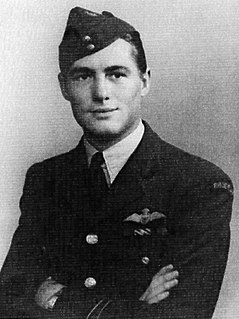 W
WPatrick Arthur Dorehill, was an officer in the Royal Air Force. A bomber pilot, he flew as flight engineer for John Nettleton during the Augsburg raid, where they carried out a daring daylight attack against the MAN U-boat engine plant at Augsburg in southern Germany, earning him an immediate DFC and his captain the Victoria Cross. He completed two full combat tours as a bomber pilot. With his commitment to combat flying completed, he was transferred to the BOAC where he flew transports. Following the war Dorehill had a lengthy career as a commercial airline pilot.
 W
WWing Commander John Reginald Dowling, was a Royal Air Force (RAF) officer and helicopter pilot famous for placing the spire of the rebuilt Coventry Cathedral on 22 April 1962. He was a Lancaster bomber pilot during the Second World War, and the author of RAF Helicopters: The First Twenty Years, a comprehensive overview of the RAF's early helicopters and their uses.
 W
WFlight Lieutenant Sydney Hastings Dowse MC was a Royal Air Force pilot who became a prisoner of war and survived The Great Escape during the Second World War.
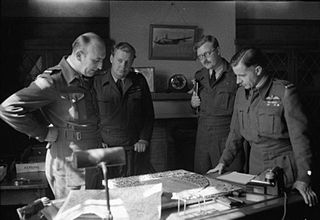 W
WAir Chief Marshal Sir Basil Edward Embry, was a senior Royal Air Force commander. He was Commander-in-Chief of Fighter Command from 1949 to 1953.
 W
WLieutenant Commander Eugene Esmonde, was a distinguished Irish pilot in the Fleet Air Arm who was a posthumous recipient of the Victoria Cross (VC), the highest award for gallantry in the face of the enemy awarded to members of Commonwealth forces. Esmonde earned this award while in command of a British Fleet Air Arm torpedo bomber squadron in the Second World War.
 W
WBrian Herbert Evans, was a Royal Air Force bomber pilot who was taken prisoner during the Second World War. Notable for his part in the 'Great Escape' from Stalag Luft III in March 1944 he was one of the men recaptured and subsequently murdered by the Gestapo.
 W
WRichard Stanley Francis was a British crime writer, and former steeplechase jockey, whose novels centre on horse racing in England.
 W
WDonald Edward Garland, VC was a bomber pilot in the Royal Air Force and a recipient of the Victoria Cross, the highest award for gallantry in the face of the enemy that can be awarded to British and Commonwealth forces.
 W
WGroup Captain Alfred Kitchener Gatward,, known as Ken Gatward, was a British Royal Air Force (RAF) pilot of the Second World War.
 W
WWing Commander Guy Penrose Gibson, was a distinguished bomber pilot in the Royal Air Force during the Second World War. He was the first Commanding Officer of No. 617 Squadron, which he led in the "Dam Busters" raid in 1943, resulting in the breaching of two large dams in the Ruhr area of Germany. He was awarded the Victoria Cross, the highest award for gallantry in the face of the enemy that can be awarded to British and Commonwealth forces, in the aftermath of the raid in May 1943 and became the most highly decorated British serviceman at that time. He completed over 170 war operations before dying in action at the age of 26.
 W
WThe Colditz Cock was a glider built by British prisoners of war for an escape attempt from Oflag IV-C in Germany.
 W
WAnthony Ross Henzell Hayter, known as Tony, was a Royal Air Force Vickers Wellington bomber pilot who was taken prisoner during the Second World War. He took part in the 'Great Escape' from Stalag Luft III in March 1944, but was one of the men recaptured and subsequently shot by the Gestapo.
 W
WJohn Vere Hopgood, was a pilot with No. 617 Squadron of the Royal Air Force (RAF). He was killed in action while taking part in Operation Chastise, popularly known as the 'Dam Busters' raid.
 W
WEdgar Spottiswoode Humphreys, known as Hunk, was a British Bristol Blenheim bomber pilot who was taken prisoner during the Second World War. He took part in the 'Great Escape' from Stalag Luft III in March 1944, but was one of the men re-captured and subsequently shot by the Gestapo.
 W
WBertram Arthur "Jimmy" James, MC, RAF was a British survivor of The Great Escape. He was an officer of the Royal Air Force, ultimately reaching the rank of Squadron Leader.
 W
WWing Commander Peter Stanley James, was a pilot in the Royal Air Force Volunteer Reserve during the Second World War, flying in RAF Bomber Command with No. 35 Squadron, No. 78 Squadron and No. 148 Squadron.
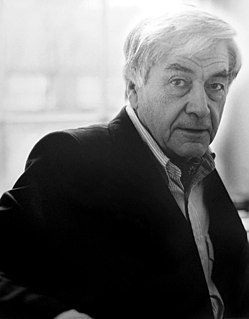 W
WRobert Kee was a British broadcaster, journalist and writer, known for his historical works on World War II and Ireland.
 W
WThomas Gresham Kirby-Green was a British Royal Air Force officer, the pilot of a Vickers Wellington bomber, who was taken prisoner during the Second World War. He took part in the 'Great Escape' from Stalag Luft III in March 1944, but was one of the men recaptured and subsequently executed by the Gestapo.
 W
WGeoffrey Dawson Lane, Baron Lane, was a British Judge who served as Lord Chief Justice of England from 1980 to 1992. The later part of his term was marred by a succession of disputed convictions. Lane's critics claimed that his refusal to believe that police evidence could be institutionally corrupt, and his reluctance to overturn the verdict of a jury, "represented a dangerous hindrance to justice". His failure to allow the appeal of the Birmingham Six in 1988 led to calls for his resignation following their successful appeal in 1991; an editorial in The Times "urged him to go", while 140 members of parliament signed a House of Commons motion to that effect.
 W
WWing Commander Roderick Alastair Brook Learoyd, VC was a Royal Air Force bomber pilot and recipient of the Victoria Cross, the highest award for gallantry in the face of the enemy that can be awarded to British and Commonwealth forces.
 W
WJames Leslie Robert Long, known as Cookie, was a British Vickers Wellington bomber pilot who was taken prisoner during the Second World War. He took part in the 'Great Escape' from Stalag Luft III in March 1944, but was one of the men re-captured and subsequently murdered by the Gestapo.
 W
WGroup Captain Thomas Gilbert "Hamish" Mahaddie, was a Scotsman who served in the Royal Air Force (RAF). As a youth he was selected for an apprentice program and was trained as an RAF ground crew "metal rigger". He had earned his wings and reached the rank of sergeant pilot by the outbreak of the Second World War. In his second tour he was selected to be a member of the newly formed "Pathfinder Force". At the end of his second combat tour he was brought onto Air Vice Marshal Don Bennett's Headquarter Staff in the position of “Group Training Inspector”. In this position he selected, recruited and trained aircrews to serve in the Pathfinder Force. Within the span of two years from the start of the war Mahaddie had risen in rank from sergeant to group captain. Following the war he continued to serve in the RAF until 1958. Out of the service he worked as an electronics consultant for the Armed Services, and as an aircraft consultant for the film industry. His most remarkable accomplishment in the film industry was the procurement of aircraft, crews and service personnel for the film Battle of Britain (1969).
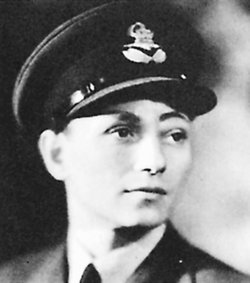 W
WWing Commander Hugh Gordon Malcolm, VC was a Scottish airman and a recipient of the Victoria Cross, the highest award for gallantry in the face of the enemy that can be awarded to British and Commonwealth forces.
 W
WSquadron Leader David John Hatfeild Maltby, was a bomber pilot in the Royal Air Force, best known for his part in the Dambusters raid. He had successfully completed over 30 operations before his death in September 1943.
 W
WLeslie Thomas Manser, VC was a British bomber pilot and a recipient of the Victoria Cross, which was awarded posthumously following an attack on the German city of Cologne.
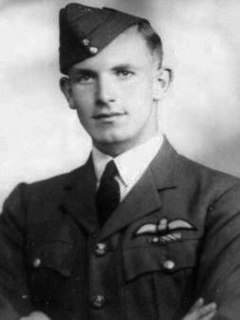 W
WJames Hardy Marks, was an officer in the Royal Air Force. An early proponent of developing a target marking method, he was the commanding officer of 35 Squadron when it was selected as one of the five founding squadrons of the Pathfinder Force. He was considered by his contemporaries as one of the top aviators of his time. He was killed while returning from a raid against Saarbrücken when his Halifax was set afire from an attack from a German night fighter. Marks stayed at the controls to allow his crew to escape before his aircraft crashed near Blesme in northern France.
 W
WJoseph Charles "Big Joe" McCarthy, was an American aviator who served with the Royal Canadian Air Force in Bomber Command during World War II. He is best known as the commander and pilot of Lancaster AJ-T ("T-Tommy") in Operation Chastise, the "Dambuster" raid of 1943.
 W
WFlight Lieutenant Walter McDonald Morison was a Royal Air Force pilot who became a prisoner of war and was sent to Colditz for attempting to steal an enemy aircraft during the Second World War.
 W
WOliver Lawrence Spurling Philpot, MC, DFC was a Canadian-born Second World War Royal Air Force (RAF) pilot and subsequently a businessman, best known for being one of the three men to successfully escape from Stalag Luft III in the escape known as The Wooden Horse.
 W
WGroup Captain Percy Charles "Pick" Pickard, was an officer in the Royal Air Force during the Second World War. He served as a pilot and commander, and was the first officer of the RAF to be awarded the DSO three times during the Second World War. He flew over a hundred sorties and distinguished himself in a variety of operations requiring coolness under fire. Some consider Pickard of the same calibre as Guy Gibson and Leonard Cheshire.
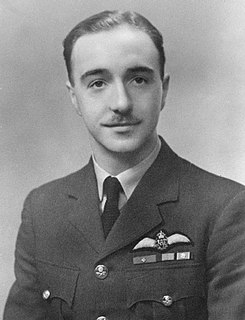 W
WWilliam Reid was a Scottish recipient of the Victoria Cross, the highest and most prestigious award for gallantry in the face of the enemy that can be awarded to British and Commonwealth forces. He earned his Victoria Cross as a pilot in the Royal Air Force Bomber Command during the Second World War.
 W
WSquadron Leader Peter Rothwell was an English bomber pilot in the Second World War and a key figure in the defence of Malta during World War II.
 W
WSquadron Leader Arthur Stewart King Scarf, VC was a Royal Air Force pilot and a recipient of the Victoria Cross, the highest award for gallantry in the face of the enemy that can be awarded to British and Commonwealth forces.
 W
WHenry Augustus Simmons was an English high jumper. He competed at the 1928 Summer Olympics and finished in 11th place. The same year he set a British junior record at 1.86 m. Simmons was a Royal Air Force officer and won the RAF high jump title in 1930, 1932 and 1935. He died in a training accident during World War II.
 W
WPeter Stevens was a German Jew who flew bombers in the British Royal Air Force in World War II. As an enemy alien living in London in the late 1930s, Hein assumed the identity of a dead schoolfriend in order to join the RAF at the outbreak of hostilities.
 W
WGroup Captain James Brian "Willie" Tait, was an officer in the Royal Air Force during and after the Second World War. He conducted 101 bombing missions during the war, including the one that finally sank the German battleship Tirpitz in 1944. He succeeded Leonard Cheshire as commander of the famous 617 Squadron and, with six gallantry decorations to his name, remains one of the most distinguished airmen in the history of the nations of the British Commonwealth.
 W
WReginald "Reg" Heber Thomas AFC was a Welsh middle-distance runner. He competed at the 1928 and 1932 Summer Olympics and the 1930 British Empire Games. He missed the 1936 Summer Olympics because of injury, and did not compete in the 1934 British Empire Games for Wales, because of English objections. At both Olympics he was eliminated in the first round of the 1500 metres event. At the 1930 Empire Games he won the gold medal in the mile and the silver medal in the 880 yards race. He could not compete for Wales because Wales did not have a national athletics association at the time. Welsh track and field athletes could only compete for England in 1930 although Welsh swimmers did compete for their home nation.
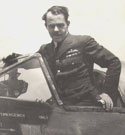 W
WGroup Captain Nicolas Tindal-Carill-Worsley RAF, was a bomber pilot during the Second World War who helped plan and execute the Great Escape from Stalag Luft III, where he was imprisoned between 1940 and 1945.
 W
WCaptain Frederick Michael Alexander Torrens-Spence, was a Royal Navy Fleet Air Arm pilot in the Second World War. Torrens-Spence earned the distinction of holding commissions in the Royal Navy, the Royal Air Force, the British Army and the Royal Ulster Constabulary.
 W
WErnest Brian Trubshaw, CBE, MVO was a leading test pilot, and the first British pilot to fly Concorde, in April 1969.
 W
WGilbert William Walenn, known as Tim Walenn, was a British bomber pilot who was taken prisoner during the Second World War. He took part in the "Great Escape" from Stalag Luft III in March 1944, but was one of the men re-captured and subsequently shot by the Gestapo.
 W
WAir Chief Marshal Sir George Augustus Walker, was a Second World War bomber pilot, a jet aircraft pioneer, and a senior Royal Air Force officer in the post-war era, as well as a rugby player.
 W
WWing Commander Kenneth Horatio Wallis was a British aviator, engineer, and inventor. During the Second World War, Wallis served in the Royal Air Force and flew 28 bomber missions over Germany; after the war, he moved on to research and development, before retiring in 1964. He later became one of the leading exponents of autogyros and earned 34 world records, still holding eight of them at the time of his death in 2013.
 W
WKenneth Wolstenholme, DFC & Bar was an English football commentator for BBC television in the 1950s and 1960s. In the final moments of the 1966 FIFA World Cup, he said "some people are on the pitch...they think it's all over....it is now!" as Geoff Hurst scored England's fourth goal. The phrase has become part of British popular culture.